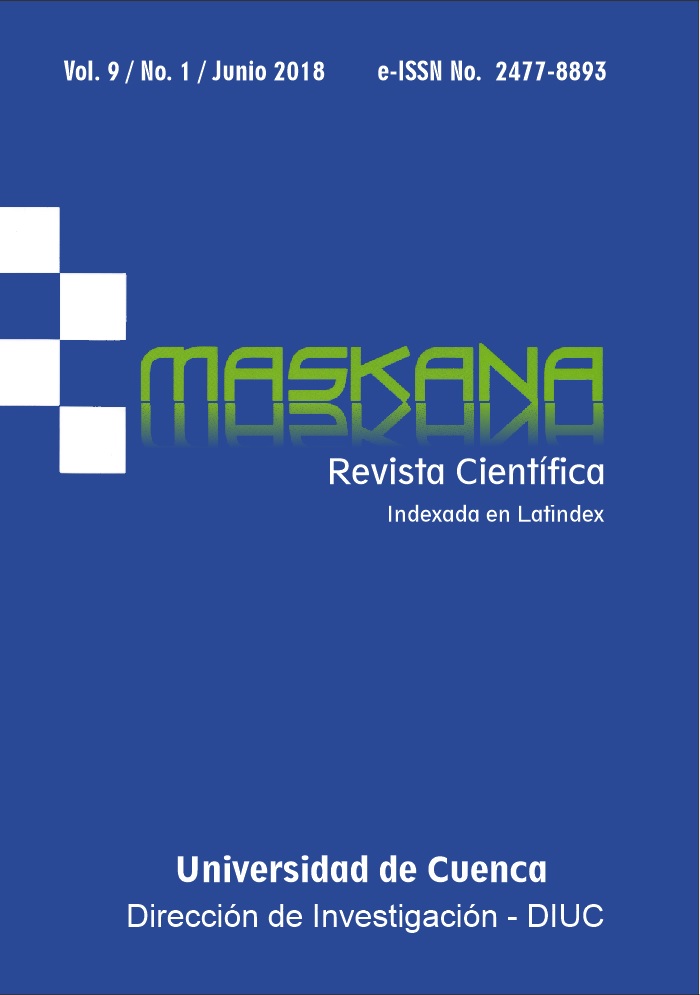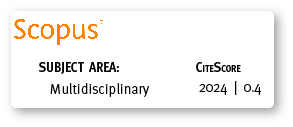Actividad adulticida y composición química del aceite esencial de hojas de Lantana camara sobre Drosophila melanogaster
DOI:
https://doi.org/10.18537/mskn.09.01.03Palabras clave:
L. Camara, aceite esencial, CG-MS, CL50-CL95, bioensayo, insecticidaResumen
El uso indiscriminado de plaguicidas sintéticos en el control de plagas y enfermedades que afectan los cultivos, la salud humana, y el medio ambiente, han conducido a resistencia por parte de insectos y presencia de residuos tóxicos en alimentos. Esto ha propiciado la necesidad de desarrollar enfoques alternativos para el control de especies plaga. El presente estudio investigó la actividad insecticida del aceite esencial de hojas de Lantana camara sobre el insecto Drosophila melanogaster. Se aisló aceite esencial de las hojas de L. camara utilizando el método de hidro-destilación. El bioensayo se realizó por el método de la OMS para determinación de actividad adulticida contra mosquitos y artrópodos. Diferentes compuestos fueron identificados por análisis de cromatografía de gases-espectrometría de masas. El valor de CL50 del aceite fue 0.56 mg cm-2 mientras que el valor de CL95 fue 0.96 mg cm-2 sobre Drosophila melanogaster. El rendimiento de aceite esencial de hojas obtenido por hidro-destilación fue 0.022% w/w. El análisis por cromatografía de gases - espectrometría de masas del aceite esencial mostro 66 picos, donde Germacren D (19.29%), B-Cariofileno (14.55%), α-Humuleno (9.51%), Biciclogermacren (8.94%), Germacren B (7.26%) y γ-Terpineno (5.62%) estuvieron presentes en mayores cantidades y contribuyeron con el 56.21% del total de los constituyentes. El aceite esencial de hojas de L. camara mostró actividad adulticida sobre la especie de mosca Drosophila melanogaster y podría ser utilizado para el desarrollo de insecticidas a base de aceite como complemento de insecticidas sintéticos para el control de moscas causantes de importantes pérdidas económicas.
Descargas
Métricas
Citas
Abdollahnejad, F., Kobarfard, F., Kamalinejad, M., Mehrgan, H., Babaeian, M. (2016). Yield, chemical composition and antibacterial activity of Artemisia dracunculus L. essential oils obtained by two different methods. Journal of Essential Oil Bearing Plants, 19(3), 574-581.
Adams, R. P. (2009). Identification of essential oil components by gas chromatography/mass spectrometry (4th ed.). Carol Stream, IL: Allured Business Media.
Beard, J. (2003). Health impacts of pesticide exposure in a cohort of outdoor workers. Environmental Health Perspectives, 111, 724-730.
Begum, S., Ayub, A., Zehra, S. Q., Siddiqui, B. S., Choudhary, M. I. (2014). Leishmanicidal triterpenes from Lantana camara. Biodiversity, 11, 709-718.
Bektas, E., Serdar, G., Sokmen, M., Sokmen, A. (2016). Biological activities of extracts and essential oil of Thymus transcaucasicus Ronniger. Journal of Essential Oil Bearing Plants, 19(2), 444-453.
Cheng, S. S., Chang, H. T., Chang, S. T., Tsai, H. K., Chen, W. J. (2003). Bioactivity of selected plant essential oils against the yellow fever mosquito Aedes aegypti larvae. Bioresources Technology, 89, 99-102.
Day, M., Wiley, C. J., Playford, J. (2003). Lantana: Current management status and future prospects. Monografía ACIAR. Disponible en http://aciar.gov.au/files/node/506/mn102lantana_current_ management_status_and_future_76357.pdf
Dharmagadda, S., Tandonb, M., Padma, V. (2014). Biocidal activity of the essential oils of Lantana camara, Ocimun sanctum and Tagetes patula. Journal of Scientific & Industrial Research, 64, 53-56.
Dua, V. K., Pande, A. C., Dash, A. P. (2010). Adulticidal activity of essential oil of Lantana camara leaves against mosquitoes. Indian Journal Medical Research, 131, 434-439.
Dua, V. K., Pandey, A. C., Singh, R., Sharma, V. P., Subbarao, S. K. (2003). Isolation of repellent ingredients from Lantana camara (Verbenaceae) flowers and their repellency against Aedes mosquitoes. Journal of Applied Entmology, 127, 509-11.
Ffrench-Constant, R. H., Daborn, P. J., Le Goff, G. (2004). The genetics and genomics of insecticide resistance. Trends Genetics, 20, 163-170.
Ffrench-Constant, R. H., Rocheleau, T. A., Steichen, J. C., Chalmers, A. E. (1993). A point mutation in a Drosophila GABA receptor confers insecticide resistance. Nature, 363, 451-453.
Finney, D. J. (1971). Probit analysis (3rd ed.). Flavour Fragrance Journal, 17, 472-477.
Ghisalberti, E. L. (2000). Lantana camara L. (Verbenaceae). Fitoterapia, 7, 467-486.
Goulson, D. (2013). Review: an overview of the environmental risks posed by neonicotinoid insecticides. Applied Ecology, 50, 977-987.
Granados, H. (2001). Spraguei seeds (Annonaceae) on two biological model of Díptera order: Drosophila melanogaster and Aedes aegypti. Afinidad, 58, 44-48.
Isman, M. B. (2015). A renaissance for botanical insecticides? Pest Management Science, 71, 1587-1590.
Khan, M., Mahmood, A., Alkhathlan, H. Z. (2016). Characterization of leaves and flowers volatile constituents of Lantana camara growing in central region of Saudi Arabia. Arabian Journal of Chemistry, 9, 764-774.
Lenika, S., Rajesh, S., Sudarshan, O. (2005). Evaluation of antimotility effect of Lantana camara L. var. aculeate constituents on neostigmine induced gastrointestinal transit in mice. BMC Complementary and Alternative Medicine, 5, 1-6.
Mansour, S. A., Messeha, S. S., Gengaihi, S. E. (2000). Botanical biocides. 4. Mosquitocidal activity of certain Thymus capitatus constituents. Boatanical biocides. Journal of Natural Toxins, 9, 49-62.
Martin, R. L., Pittendrigh, B. R., Reenan, R., Ffrench-Constant, R. H., Hanck, D. A. (2000). Point mutations in domain III of a Drosophila neuronal Na channel confer resistance to allethrin. Insect Biochemistry and Molecular Biology, 30, 105-109.
Mei, C. (2005). Residential exposure to pesticide during childhood and childhood cancers: a meta-analysis. Pediatrics, 136, 719-729.
Naqqash, M. N. (2016). Insecticide resistance and its molecular basis in urban insect pests. Parasitology Research, 115, 1363-1373.
NIST Mass Spectrometry Data Center. (2005). NIST/EPA/NIH Mass Spectral Library (NIST 05) and NIST Mass Spectral Search Program (Version 2.0d). Gaithersburg, MD: National Institute of Standards and Technology. Disponible en http://www.sisweb.com/manuals/nist05manual.pdf
Oliveira, J. C., Neves, I. A., Camara, C. A., Schwartz, M. O. (2008). Essential oil composition of two Lantana species from Mountain Forests of Pernambuco (Northeast of Brazil). Journal of Essential Oil Research, 20(6), 530-532.
Padalia, R. C., Verma, R. S., Sundaresan, V. (2010). Volatile constituents of three invasive weeds of Himalayan region. Records of Natural Products, 4(2), 109-114.
Panella, M. A., Dolan, M. C., Karchesy, J. J., Xiong, Y., Peralta-Cruz, J., Khaswneh, M. (2005). Use of novel compounds for pest control: Insecticidal and acaricidal activity of essential oil components from heartwood of Alaska yellow cedar. Journal of Medical Entomology, 42, 352-8.
Pedra, J. H., McIntyre, L. M., Scharf, M. E., Pittendrigh, B. R. (2004). Genome-wide transcription profile of field- and laboratory selected DDT-resistant Drosophila. Proceedings of the National Academy of Science, 101, 7034-7039.
Rajashekar, Y., Kumar, H. V., Ravindra, K. V., Bakthavatsalam, N. (2013) Isolation and characterization of biofumigant from leaves of Lantana camara for control of stored grain insect pests. Industrial Crops and Products, 51, 224-228.
Rajashekar, Y., Raghavendra, A., Bakthavatsalam, N. (2014). Acetylcholinesterase inhibition by biofumigant (Coumaran) from leaves of Lantana camara in stored grain and household insect pests. BioMed Research International, 2014, 6 p.
Rajashekar, Y., Ravindra, K. V., Bakthavatsalam, N. (2014). Leaves of Lantana camara Linn. (Verbenaceae) as a potential insecticide for the management of three species of stored grain insect pests. Journal of Food Science Technology, 51(11), 3494-9.
Sathish, R., Vyawahare, B., Natarajan, K. (2011). Antiulcerogenic activity of Lantana camara leaves on gastric and duodenal ulcers in experimental rats. Journal of Ethnopharmacology, 134, 195-197.
Secretaría de la Convención Internacional de Protección Fitosanitaria CIPF (2006). Normas internacionales para medidas fitosanitarias. Italia Roma, pp. 329-342.
Sharma, O. P. (1981). A review of the toxicity of Lantana camara (Linn) in animals. Clinical Toxicology, 18, 1077-1094.
Sharma, O. P., Makkar, H. P., Dawara, R. K. (1988). A review of the noxious plant of Lantana camara. Toxicon, 26, 975-987.
Sharma, O. P., Singh, U. A., Sharma, S. (2000). Levels of lantadenes, bioactive pentacyclic triterpenoids, in young and mature leaves of Lantana camara var. aculeate. Fitoterapia, 71, 487-491.
Sousa, E. O., Almeida, T. S., Menezes, I. R., Rodrigues, F. F., Campos, A. R., Lima, S. G. (2012). Chemical composition of essential oil of Lantana camara L. (Verbenaceae) and synergistic effect of the aminoglycosides Gentamicin and Amikacin. Records of Natural Products, 6(2), 144-150.
Suazo, G. F., González, F., Urbina, A., Pastene, E., Sáez, K., Serri, H., Chávez, R. (2012). Actividad insecticida del aceite esencial de Lepechinia chamaedryoides (Balb.) Epling en Drosophila melanogaster. Gayana Botánica, 69(2), 256-266.
Sukumar, K., Perich, M. J., Boobar, L. R. (1991). Botanical derivatives in mosquito control: a review. Journal of the American Mosquito Control Association, 7, 210-237.
Tabashnik, B. E. (1994). Evolution of resistance to Bacillus thuringiensis. Annual Review of Entomology, 39, 47-79.
Valarezo, E., Rosillo, M., Cartuche, L., Malagón, O., Meneses, M., Morocho, V. (2013). Chemical composition, antifungal and antibacterial activity of the essential oil from Baccharis latifolia (Ruiz & Pav.) Pers. (Asteraceae) from Loja, Ecuador. Journal of Essential Oil Research, 25(3), 233-238.
Valarezo, E., Arias, A., Cartuche, L., Meneses, M., Ojeda, S., Morocho, V. (2016). Biological activity nd chemical composition of the essential oil from Chromolaena laevigata (Lam.) R.M. King & H. Rob. (Asteraceae) from Loja, Ecuador. Journal of Essential Oil Bearing Plants, 19(2), 384-390.
World Health Organization, WHO. (1981). Instruction for determining the susceptibility or resistance of adult mosquitoes to organochlorine, organophosphate and carbamate insecticide - Diagnostic test. Geneva, Switzerland: WHO/VBA/81.807.
Yang, P., Yajun, M. A, Shuiqing, Z. (2005). Adulticidal activity of five essential oils against Culex pipiens quinquefasciatus. Journal of Pesticide Science, 30, 84-9.
Descargas
Publicado
Cómo citar
Número
Sección
Licencia
Copyright © Autors. Creative Commons Attribution 4.0 License para cualquier artículo enviado a partir del 6 de junio de 2017. Para los manuscritos presentados anteriormente, se utilizó la licencia CC BY 3.0.
![]()
Usted es libre de:
 |
Compartir — compartir y redistribuir el material publicado en cualquier medio o formato. |
 |
Adaptar — combinar, transformar y construir sobre el material para cualquier propósito, incluso comercialmente. |
Bajo las siguientes condiciones:
 |
Atribución — Debe otorgar el crédito correspondiente, proporcionar un enlace a la licencia e indicar si se realizaron cambios. Puede hacerlo de cualquier manera razonable, pero de ninguna manera que sugiera que el licenciador lo respalda a usted o a su uso. |
| Sin restricciones adicionales: no puede aplicar términos legales o medidas tecnológicas que restrinjan legalmente a otros a hacer cualquier cosa que permita la licencia. |
Mayor información sobre este acuerdo de autoría y licencia, transferencia de derechos o solicitudes de reproducción, pueden ser consultados en este enlace.









